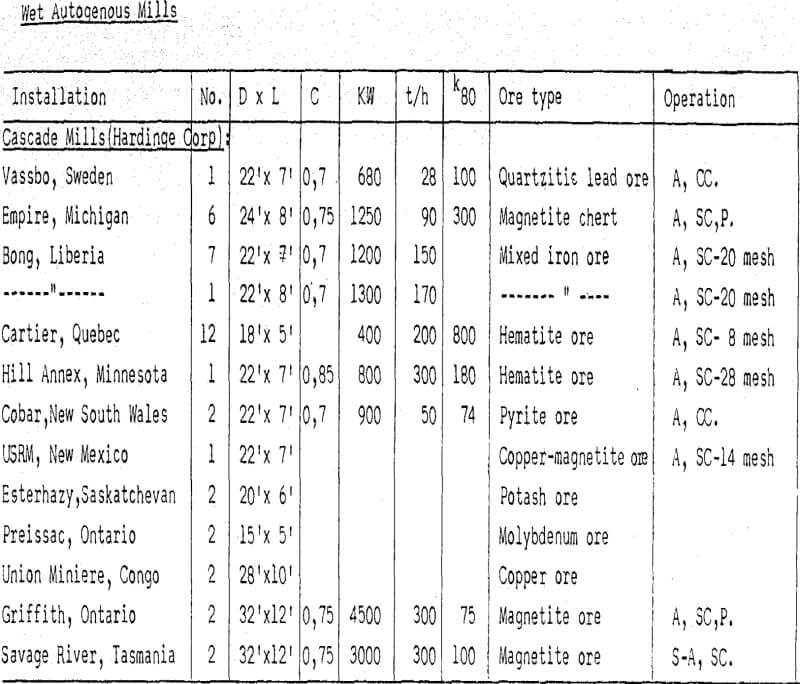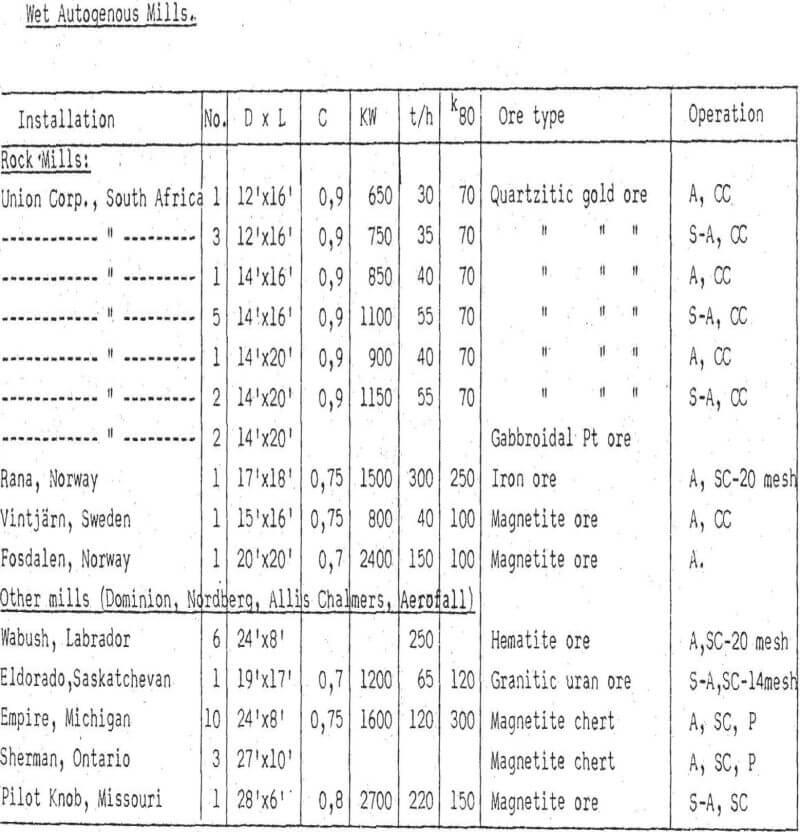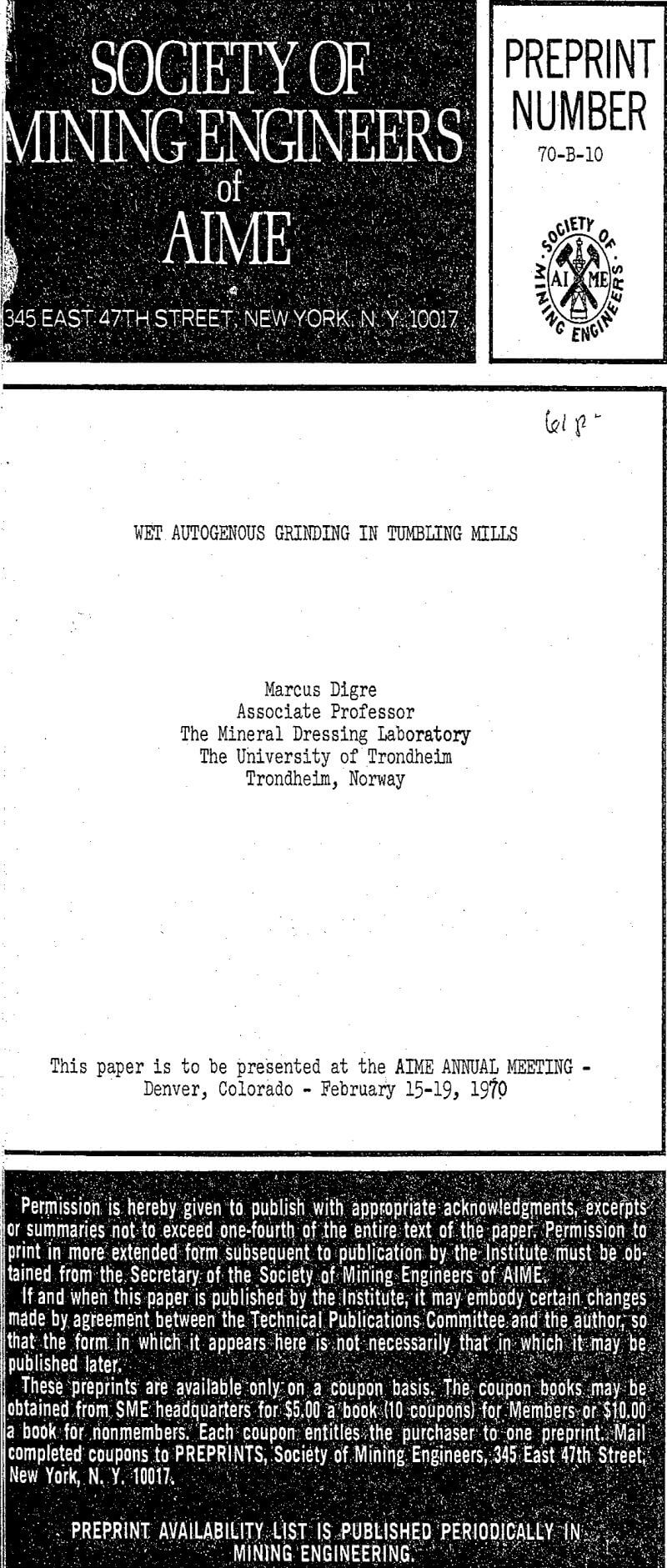Table of Contents
The autogenous grinding method has been progressively employed in mineral dressing plants during the last 15 years. The term has been used with somewhat different meanings. In this paper the author will use it in the most restricted way, for processes where run-of-mine ore (rock) in one step is reduced to a grind product by the action of the ore itself without any other grinding media present. The pebble grinding process where the major part of the ore enters the mill as finely crushed product which is ground further with selected coarse ore pieces acting as grinding media, is not considered autogenous grinding. Processes where a minor amount extraneous media as steel balls is added to supplement an autogenous mill charge will be called semiautogenous.
Autogenous Grinding Mechanisms
Autogenous grinding is at present carried out in tumbling mills of the same types as used in ball mill grinding. The similarities in equipment and procedure have led to the commonly held assumption that the grinding mechanisms are the same in the two processes, with the coarse part of the ore charge taking over the function of the ball charge. This view is largely correct when considering pebble grinding, but the situation is another in the true autogenous grinding, where run-of-mine ore is ground fine without any intermediate crushing.
In ball mills relatively small ore particles are ground fine by the tumbling action of a charge of larger steel balls. Comminution in ball mills is usually described as taking place by “impact” and “attrition” grinding. When the ore particles are crushed by direct hits from falling balls we get impact grinding, while attrition grinding is more loosely defined as the comminution caused by the sliding and rolling action of the balls in the moving charge. In both cases the comminution is caused by stressing the ore above the breaking strength limit, which leads to cracking of the ore particles. Besides the cracking some abrasion takes place where individual grains or grain fragments are torn loose from the ore particles by frictional forces. In ball mill grinding abrasive conditions are usually avoided owing to the associated high wear rate of the grinding balls.
In present autogenous grinding abrasion is usually the main reduction mechanism, and the impact and attrition processes may even be detrimental to the grinding operation. The ore feed to an autogenous grinding operation typically consists of ore pieces from 10″ size and downward with 50% coarser than 3 – 4″ and only a small amount, say 10 – 20%, finer than 1″. The coarser ore pieces can be reduced either by impact cracking or by abrasion, and only the finest part is ground by attrition between the larger pieces by the same actions as in ball and pebble grinding. Since the finer material is only a minor part of the total this “conventional” grinding is less important.
During autogenous grinding in a tumbling mill the ore pieces are rubbed against each other and gradually worn down by abrasion until they are small enough to be caught between the larger pieces. Observations on equilibrium ore charges from operating mills show a typical progress in this process depending upon size of the ore pieces and the time they have spent in the mill. The ore feed from the coarse crushing plant consists of jagged irregular pieces, typically with 20 – 50% coarser than 4″ and 10 – 20% finer than 1″. The original pieces of +1″ material are rapidly rounded off, first by chipping off the prominent points and edges, and then by further smoothing of the surface. As the rounding- off proceeds, the size of the chips and the wear rate decreases rapidly giving a gradually transfer to the second stage, true abrasion of the rounded pieces (pebbles). The amount of material removed in the first stage will usually be 10 – 20% of the original piece weight, and will be in the form of chips and individual mineral grains.
In the next stage the rounded pieces are gradually reduced in size by a steady removal of mineral grains from the surfaces until the pieces are small enough to be “nipped” between the larger pebbles present in the charge. This action takes place when the pieces are reduced to about one tenth of the dominant feed size, usually in the order of 10 mm (½ inch). It also depends to a degree upon ore strength and surface roughness. The total amount reduced by abrasion during the second stage will run from 60 – 90 % of the feed, and the product will contain mainly individual mineral grains and grain fragments.
When the pebbles are small enough to be “nipped” the process enters the third stage, here called “Conventional” grinding. The small pebbles together with the original fines in the feed and the abrasion products from the two first stages are attrition ground between the larger pebbles before being swept out of the mill. The attrition product will have a distribution similar to the usual ball and pebble mill products. It will amount to 20 – 50% of the combined mill product depending upon grinding conditions.
The steady-state abrasion rate for like surfaces under autogenous grinding conditions will mainly depend upon following factors:
- Hardness, cleavability, plasticity of mineral grains in ore.
- Size and shape of mineral grains.
- Bond strength between grains.
- Bulk elasticity of ore.
- Topography and curvature of contact areas.
- Pressure at contact areas.
- Differential tangential velocity for surfaces in contact.
- Medium present in contact area (Air, water, pulp, a.o.).
The factors mentioned above will determine the (tangential) frictional forces between the contact surfaces and thus the energy available for performing the abrasion work.
For plane surfaces of elastic rock material composed of equalsized hard mineral grains in a weaker bond matrix, the abrasion rate is ideally proportional to contact force Fc and differential contact velocity Vc and inversely to contact area ac.
∝ = K · Vc · Fc/ac = K · Vc · Pc……………………………………(1)
where the average contact pressure pc equals Fc/ac. The assumption is that the surfaces make contact at a number of discrete points and that the number of contact points increase linearily with pressure.
Apart from ore or rock characteristics, the kinetics of the mill charge are most important for the abrasion rate in autogenous mills. The movements of the charge in a tumbling mill depend primarily upon mill speed, diameter and charge volume. Liner profile, size distribution of mill charge, and internal friction in charge are secondary factors. In the first approach we disregard them and assume a no-slip liner, evensized spherical pebbles much smaller than mill diameter and constant frictional conditions. The mill charge can be expressed as “charge number” M indicating the fraction of the mill volume occupied by the charge. For usual operations M will be in the region 0,3 – 0,4 (30 – 40%).
Both theory and experiments have shown that the charge movement pattern is determined by a dimensionless “speed number” C which equals the square root of the quotient between centripetal and gravitational forces acting on the pebbles at the mill shell:
![]()
where n = mill speed in rpm, D = inside mill diameter, and “f” is the slip factor indicating the lag between mill charge and shell. For the no-slip case f equals zero. 100 x C is then the “critical speed” of the mill in %. For autogenous mills C is usually in the range 0,6¬0,9 (60 – 90%).
For C values up to 0,70 the movement of the pebbles will be “cascading” that is when reaching the high side of the mill, the pebbles roll and slide downwards while keeping in contact with the rest of the charge.
When C increases beyond 0,70 the charge will start “cataracting” with an increasing number of pebbles thrown clear of the rest of the charge for some part of the cycle. During this time obviously no abrasion can take place, and the kinetic energy is expended as impact when the pebble again hits the charge or the shell.
The expressions that have been derived up to now have been based on a charge assumed to consist of equalsized pebbles This is not the case in real autogenous grinding, and next we must consider the effect of a charge of mixed pebble sizes. A number of equilibrium pebble (and ball) charges have been investigated and the results indicate that the linear abrasion rates will be roughly the same for all the pebbles in a given charge except for the excess wear in the rounding-off period. The size distribution of the equilibrium pebble charge over most of the size range then will be conform to and linearly displaced from the size distribution of the mill feed. In the fine size range the charge will show a strong depletion as soon as the third stage attrition grinding takes effect. The overall result is a preponderance of pebbles in the size corresponding to 50 – 80% passing for the feed and both the contact velocity vc and the contact pressure pc should mainly depend upon the pebbles in this size range. As an approximation the d50 for the feed could be taken as the relevant pebble size for mixed-size charges, and used as pebble diameter d in the expressions developed for vc and pc for evensized pebbles.
Another factor that must be taken in account is the segregation in the mill charge. If all pebble sizes were distributed randomly within the charge the contact forces between pebbles should also be distributed randomly around a value determined by the average pebble size.
For a segregated charge the different pebble sizes will be more or less concentrated in certain areas, and the contact forces will mainly depend upon the average pebble size in the area. In autogenous mills the coarse pebbles normally segregates radially towards the periphery leaving an excess of fine pebbles in the upper central part of the charge. The forces and pressures here will tend to become very low due to the combined effects of small pebbles and shallow depths.
The segregation regardless of where and how it takes place also will have a negative effect on the abrasion grinding by causing a selective depletion of the larger pebbles in the charge.
Impact cracking in tumbling mills has two causes, either the blow of the protruding parts of the mill liner against the ore pieces in the charge or the impact caused by flying balls or pebbles when hitting the charge or the shell liner. The first operates both at cascading and cataracting speeds, the second only at cataracting.
The next question that arises is how the cracking incidence is related to the impact energy delivered to a pebble. The velocities will be in the range from 1-5 m/second, and it is known from impact crushers that velocities in the range from 10 – 50 m/sec. are needed for efficient crushing of usual ores and rocks. Pieces with internal flaws may crack more easily, but reasonably competent and homogenous materials should not be broken by single blows of this intensity. Repeated blows are another matter and as it is known that brittle materials usually have very low fatique strengths, cumulative blow effects are probably the main cause of cracking. The blow frequency is in the order of 1-5 blows/min. and as residence times for individual pebbles are 20 minutes and upward to several hours, the total blow number may be considerable.
Operational Aspects
The results obtained from operating and testing autogenous grinding installations strongly indicates that abrasion grinding is the main operative mechanism, and that the key to success in this field is to create conditions favouring abrasion.
With conventional crushing and grinding equipment literally any rock or ore material can be reduced to any desired fineness.
The fundamental limitation of the autogenous grinding process is that the structural characteristics of the material to be ground are the overriding factors determining both the overall applicability of the process and the range of product finenesses it can furnish. Extensive testing and careful design is therefore needed to assure successful autogenous operations.
The ideal feed to an autogenous grinding operation is an ore with a maximum amount of coarse pieces around 75-150 mm 3″- 5″) size. The ore structure should consist of hard isometric grains bonded together by a weaker matrix material. However, the strength of the matrix should be sufficient to withstand the cumulative effect of impact blows in the mill for even the largest ore pieces present. An ore with such characteristics should wear down by abrasion until the pebbles are small enough to be reduced by attrition.
Adjustment of an autogenous grinding system to a finer product than the optimum can be accomplished by using conditions favouring attrition. Grinding in closed circuit with cyclones or screens will work in this direction, and the product size will usually decrease with increasing circulating load. But at the same time both mill capacity and grinding efficiency will drop due to decreasing abrasion action. At very high circulating loads the amount of residing pulp may get so high that it reduces both the abrasion and attrition action. Grinding in closed circuit therefore have a limited effect on product fineness, and grind efficiency tend to drop when circulating loads increase beyond 100%. The most successful autogenous operations usually restricts the closed circuit to scalping off and returning only a small amount of stray oversize.
The cracking phenomenon is the major difficulty one has to cope with in autogenous grinding, but it is seldom that the situation gets out of hand, especially if the problem has been considered during the design of the circuit. The main cause for trouble of this kind is ores with excessive slaty or fractured structures.
Large variations in operating results due to changes in mill feed quality is usually the most serious problem in autogenous grinding. In some cases the difficulties are due to geologic features of the orebody. Changing mineral composition and grain size is one disturbing factor, another is differences due to oxidation of part of the orebody. The last influence has been very disturbing for some installations in tropic or subtropic climates. Similar difficulties may be traced to the mining conditions where the mode of breaking and handling the ore can lead to differences in the size distribution and the strength of the ore delivered to the mill.
Regardless of the blending steps taken, the mill feed will always show qualitative short-term fluctuations, which in some cases may cause the operating results to fall outside the allowed limits. Some kind of mill circuit control then will be necessary, and a number of different regulating schemes are in operation or have been tried. The requirements of the customers or the following processes on the product are usually such that a stable fineness of grind in the circuit is one objective. Depending upon circumstances the next control objective is to obtain either constant throughput at all times or the maximal throughput that the conditions at each time will allow.
At higher charges the relation to power departs from straight proportionality. With increasing mill charge the power will go through a maximum, usually at M between 0,45 and 0,50,and then decrease again, and the grinding capacity will follow the power. The cause for this behavior is that the charge movements are impeded when the mill fills up. This effect will further decrease the abrasion rate and in this way enforce the charge swelling caused by a decrease in ore grindability. The mill will therefore loose its self-regulating, property and become instable in this region. The method of setting a fixed feed rate and leave the rest to the mill therefore only will work out well below the mill’s maximal capacity. Another control method that frequently is used for autogenous mills, is to regulate the feed so to keep a constant power load, as close to the maximum as is deemed safe with respect to the ore changes. The charge is then kept within a narrow range which gives better utilization of mill capacity, but the feed rate and to some extent the product size might fluctuate appreciably.
The most promising attack on the regulating problem is to include the feed size distribution as a controlled variable. This method has been tried at 3 or 4 plants, partly for regulating and partly for blending purposes, but usually have been discarded due to operational troubles. The most successful application is at Cobar Mine in Australia where the ore is fed in two size fractions at controlled rates. In this way they have been able to even out both the total feed rate and the mill power draft and thus stabilize the operation.
Wet autogenous grinding is the most important comminution development for mineral dressing purposes since the breakthrough of the ball mill. The fundamental mechanisms of the process are imperfectly known and research in this direction will certainly further the use of the method materially. The results from operating mills and pilot tests strongly points to abrasion grinding as the most important and favourable mechanism, while impact cracking is a detrimental effect and in cases a limiting factor for the application.



